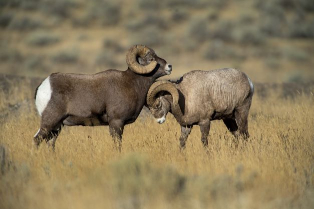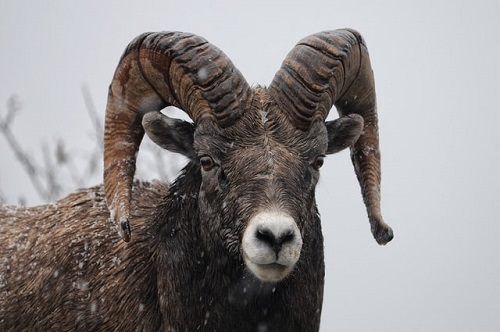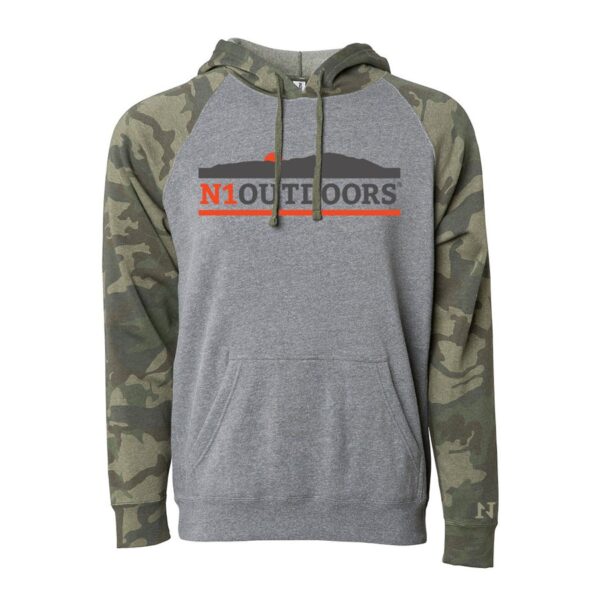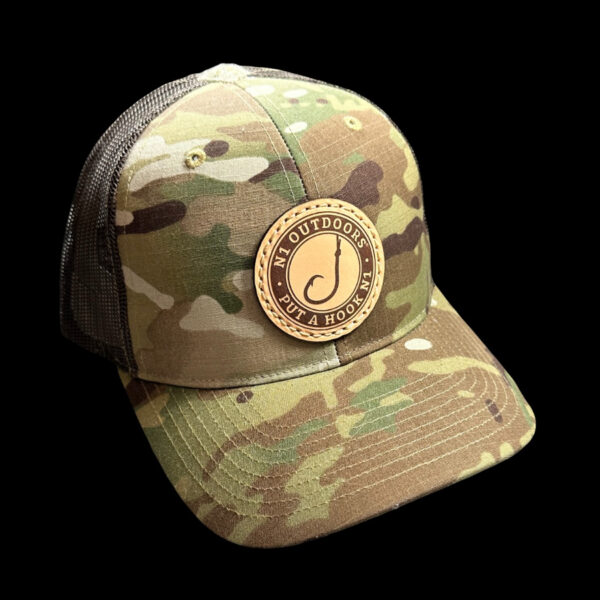“Bighorn sheep” includes Rocky Mountain bighorn and desert bighorn.
The Rocky Mountain bighorn is bigger and can be found in Idaho, Washington, Wyoming, Montana, the Alberta Canadian provinces, and British Columbia.

While bighorn sheep can be found in several southwestern U.S. states, they are also hunted as an exotic species in countries like Uruguay.
Desert bighorns are found in the mountain ranges of the southwestern US, including Arizona, Utah, Nevada, New Mexico and California.
In countries such as Uruguay, bighorn sheep can be hunted as an exotic species.
Bighorn hunting can start early or late August and run to October and November. In Mexico, hunts may continue to the end of March. September and October are deemed as some of the best times to hunt bighorn sheep.
Bighorn Sheep Hunting Tips
Bighorn sheep hunts are often done with the assistance of a guide or outfitter and the hunts are usually spot-and-stalk.
Thanks to their protective coloring, bighorn sheep are next to invisible on mountain slopes. And, because they’re always keen and alert, it may be difficult to approach them.

Because of their coloring, bighorn sheep can be very difficult to see, which makes them a challenge to hunt.
Uncontrolled hunting, diseases, and habitat loss have reduced the range and numbers of the bighorn sheep, making them one of the most desirable and challenging mountain hunting trophies to take.
To harvest a trophy bighorn, you will often have to cover miles of difficult terrain, staying keenly aware of the environment, and exhibiting endurance and patience.
So, let’s cover some bighorn sheep tracking and hunting tips!
Maximize Your Chances [Hire A Registered Outfitter]
Mountain hunting involves covering various terrains. Because outfitters should know every part of the terrain you are hunting, it should improve your chances by not unduly pressuring the target animal.
With the help of an outfitting guide, chances of you going home with a trophy are much higher, as their job and reputation hinges on maximizing your success.

You might want to consider hiring a guide or outfitter service when chasing a trophy sheep. Knowing where to begin looking is half the battle.
It is customary for outfitter packages, such as sheep hunting in BC for example, to include room and board.
There’s usually something for everyone, including chalets, rustic cabins, and campgrounds for the camping type. Meals are also included, making the hunting trip more pleasant.
Outfitters track the goings and comings of each hunter, so that your safety is assured.
Where To Find Bighorn Sheep
The key to bighorn sheep hunting is being able to find them in the first place.
However, it’s challenging to spot sheep in any surrounding.
Your outfitter should know where to focus your glassing efforts, so follow their lead. First light is an excellent time to spot bighorn sheep moving or feeding.

Bighorn sheep are likely to be feeding in the morning and afternoons, giving you a chance to glass feeding areas.
It may be difficult to find them at mid-day, as they’re usually bedded down, making it a good time for you to change locations.
You’ll most likely spot more sheep when glassing and sitting than when walking, so don’t feel like you have to be constantly covering ground.
Gather Intel
There are some important things to consider not only when scouting, but when considering where to scout.
You can save yourself a lot of time and money by communicating and spending time with sheep hunting experts to learn more about where to begin your hunt.
Try checking out sheep hunting Facebook groups and online forums. Also, consider attending fundraisers that attract bighorn sheep hunters.
Also, don’t be stingy with any good information you might have. Sharing good intel may lead to other sheep hunters reciprocating the gesture.
Use Technology To Your Advantage
While paper maps are still a good option, identifying productive bighorn sheep ranges is done more easily with high-tech tools such as Google Earth.
Considering that only small portions of the mountains may hold sheep, it’s invaluable to have satellite images of your hunting terrain.
Select Key Terrain
Now, while using mapping tools such as Google Earth can be extremely helpful, equipping yourself with high-tech imagery is useless if you don’t know where to look.
While you may find sheep anywhere within their range, the key is identifying where they spend most of their time.

One of the keys to successful hunts of bighorn sheep is figuring out where they spend most of their time. Food, shade, bedding and escape routes are all key areas of focus.
Considering escape routes and food is key to identifying terrain where bighorn sheep may be located.
Sheep can go for a long time without water, and food is secondary, provided they have rugged terrain close by where they can easily escape from predators.
If you spot a high basin with excellent grass growth and an escape route, then that’s a desirable place for sheep to reside.
Choosing An Area
If you’re going on your first bighorn sheep hunt, you might want to consider high-percentage areas.
However, if you are seeking a mature, high-scoring bighorn sheep, looking in the less productive regions with lower hunting pressure can sometimes provide good results.

Keep in mind that heavy snow can push bighorn sheep to lower elevations.
Be sure that the terrain of the area you choose to hunt matches your fitness level and hunting style. If you are able to choose an area that is close to your residence, that is a big win, as you can more readily scout it throughout the year.
Summer scouting is also a good idea, as it allows you to study the access routes and terrain to avoid wasting time trying to figure things out during the hunting season.
Weather Matters
For most of the summer and early winter, sheep remain in the mountains unless pressured.
However, heavy snowfalls can push them lower down the mountains to warmer temperatures and south facing slopes.
Glass The Terrain
To become an effective sheep hunter, you’ll need a quality spotting scope and excellent binoculars.
You also need patience as you have to give glassing enough time. With binoculars, start with a quick scan of the spots most likely to hold bighorn sheep.
In early mornings and late afternoons, the sheep are likely to be feeding, so concentrate on grassy areas.
On hot days, bighorn sheep will bed down under cliffs or rocky overhangs to stay cool from the sun.
If you don’t initially spot a sheep with your binoculars, consider a more detailed search, scanning in a the mountainside in a grid pattern. If you still don’t spot a bighorn, try moving 50-100 yards and glassing again. It’s amazing what you can see with a small angle/position change.
-
Sale!

Put A Hook N1™ Offshore TriBlock Leather Patch Hat
Original price was: $26.99.$15.00Current price is: $15.00. Select options This product has multiple variants. The options may be chosen on the product page -

N1 Outdoors® TriBlock™ Duck Leather Brackish Camo Patch Rope Hat
$29.99 Select options This product has multiple variants. The options may be chosen on the product page -

N1 Outdoors® Woodland Camo Deer Antler Flat Bill Hat
$29.99 Select options This product has multiple variants. The options may be chosen on the product page
Be Physically Ready
Bighorn hunting is physically taxing. A successful sheep hunting trip highly depends on your physical preparedness because these hunts will test your endurance.
Your success or failure can directly relate to your conditioning.
So, before each bighorn sheep hunt, it’s a good idea to get into a daily routine that may include climbing a flights of stairs or jogging a few to several miles.
You can also load your backpack with up to 40 pounds of gear and then hit the trail.
This can not only help you achieve some personal fitness goals, but also some sheep hunting goals, so that you can have a fantastic hunting experience and no regrets.
Final Thoughts on Sheep Hunting Tips
Don’t forget to practice timing your range by taking shots at different ranges and angles until you’re confident with your ammunition and rifle.
If you are a bowhunting bighorn sheep, be sure your gear has been inspected routinely, but that your shooting skills have been honed so your arrow will fly true when your moment of truth comes!
Your bighorn sheep hunting success depends on your ability to track the sheep. We hope you find the above tips useful for tracking and hopefully harvesting a bighorn sheep!



























































